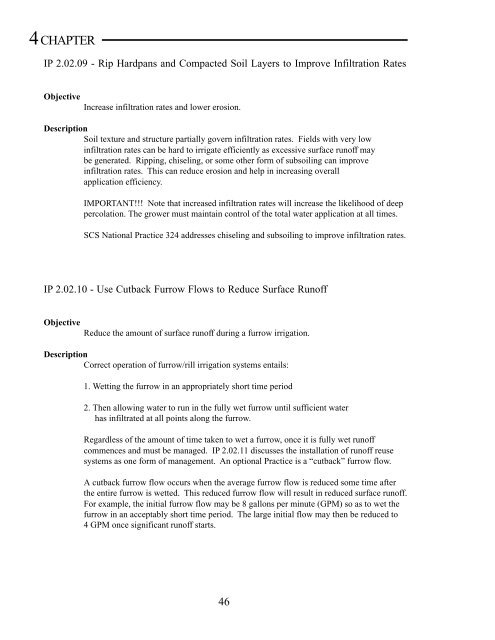Em4885 irrigation management practices to protect ground water
Em4885 irrigation management practices to protect ground water
Em4885 irrigation management practices to protect ground water
Create successful ePaper yourself
Turn your PDF publications into a flip-book with our unique Google optimized e-Paper software.
4 CHAPTER<br />
IP 2.02.09 - Rip Hardpans and Compacted Soil Layers <strong>to</strong> Improve Infiltration Rates<br />
Objective<br />
Increase infiltration rates and lower erosion.<br />
Description<br />
Soil texture and structure partially govern infiltration rates. Fields with very low<br />
infiltration rates can be hard <strong>to</strong> irrigate efficiently as excessive surface runoff may<br />
be generated. Ripping, chiseling, or some other form of subsoiling can improve<br />
infiltration rates. This can reduce erosion and help in increasing overall<br />
application efficiency.<br />
IMPORTANT!!! Note that increased infiltration rates will increase the likelihood of deep<br />
percolation. The grower must maintain control of the <strong>to</strong>tal <strong>water</strong> application at all times.<br />
SCS National Practice 324 addresses chiseling and subsoiling <strong>to</strong> improve infiltration rates.<br />
IP 2.02.10 - Use Cutback Furrow Flows <strong>to</strong> Reduce Surface Runoff<br />
Objective<br />
Reduce the amount of surface runoff during a furrow <strong>irrigation</strong>.<br />
Description<br />
Correct operation of furrow/rill <strong>irrigation</strong> systems entails:<br />
1. Wetting the furrow in an appropriately short time period<br />
2. Then allowing <strong>water</strong> <strong>to</strong> run in the fully wet furrow until sufficient <strong>water</strong><br />
has infiltrated at all points along the furrow.<br />
Regardless of the amount of time taken <strong>to</strong> wet a furrow, once it is fully wet runoff<br />
commences and must be managed. IP 2.02.11 discusses the installation of runoff reuse<br />
systems as one form of <strong>management</strong>. An optional Practice is a “cutback” furrow flow.<br />
A cutback furrow flow occurs when the average furrow flow is reduced some time after<br />
the entire furrow is wetted. This reduced furrow flow will result in reduced surface runoff.<br />
For example, the initial furrow flow may be 8 gallons per minute (GPM) so as <strong>to</strong> wet the<br />
furrow in an acceptably short time period. The large initial flow may then be reduced <strong>to</strong><br />
4 GPM once significant runoff starts.<br />
46
















